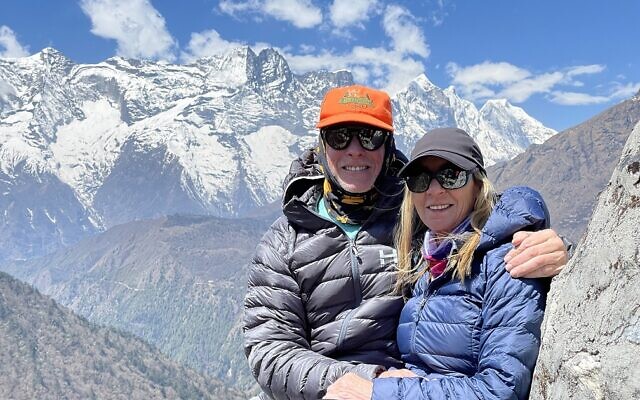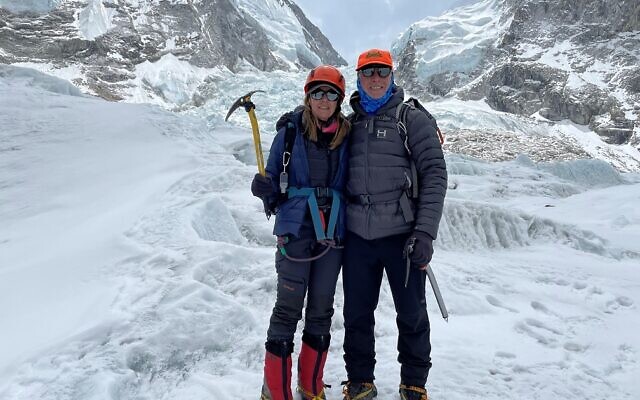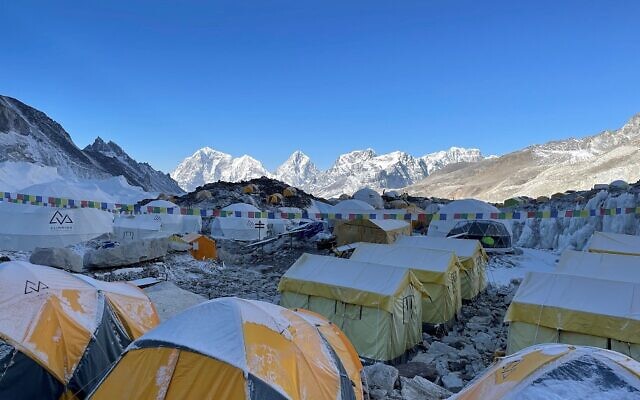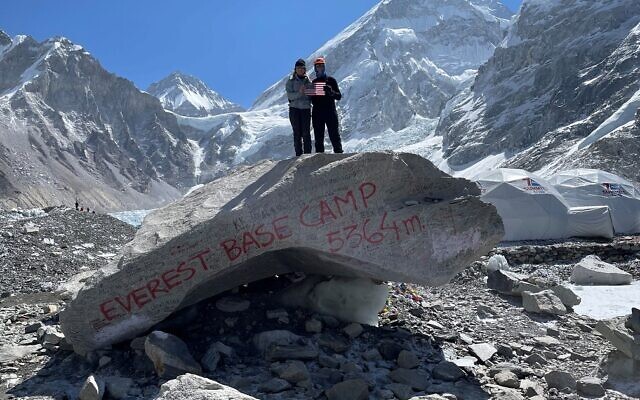Couple Climbs Everest with Monk’s Blessing
Lana Imerman and Lenny Silverstein trained for months, then set off for the experience of a lifetime among clouds, ice, and yak dung.
After 37 years with the Atlanta Journal-Constitution and now with the AJT, , Jaffe’s focus is lifestyle, art, dining, fashion, and community events with emphasis on Jewish movers and shakers.

Lana Imerman planned to trek to Mt. Everest Base Camp in 2015. Unfortunately, there was a massive avalanche which caused that trip to be canceled.
She said, “I never thought that I would ever fulfill this life-long dream until Lenny [Silverstein] suggested that we trek together.”
Imerman, who had previously climbed Mount Kilimanjaro and Machu Picchu, found Mt. Everest to be difficult, but not harder than expected. She explained, “Mt. Everest was quite a challenge, both in terms of physical and mental difficulty and altitude.”

Unlike Imerman, Silverstein had no prior experience climbing mountains. They both trained on their own and with a personal trainer. Lenny added, “We worked with an altitude trainer locally who helped experience what 21,500 feet high feels like. He also taught breathing techniques.”
Imerman and Silverstein left Atlanta on March 31 to arrive in Kathmandu (through Doha, Qatar) on April 2. They arrived a day early to start acclimating to the altitude. They met up with their tour group in the afternoon and began training in Kathmandu. The next day, they left early via helicopter to fly to Lukla, elevation 9,337 feet. From Lukla, they commenced their trek up to Mt. Everest Base Camp (EBC), spending the nights in various villages and camps – Namche Bazaar, Tengboche, Lobuche, and Gorak Shep.

While in Tengboche, they visited the Tengboche Monastery, where they received a monk’s blessing for a safe and successful journey. Imerman recalled, “It was eye-opening to see how the people live off the land. Electricity, for the most part, was non-existent the higher we trekked unless there was some sort of generator or solar panels. The tea houses and camps typically had no heat other than a central wood or dried-yak dung pot stove in a common room. Everything is transported on the backs of humans, yaks, or mules.”
Their trek to base camp took 11 days, including layover days for further acclimation. On those days, they trekked up to higher elevations, then back down for the evening. Along the way to EBC, they climbed Kala Patthar, (altitude of 18,500 feet).
Silverstein stated, “While climbing Kala Patthar, we watched the most amazing sunrise over the summit of Mt. Everest, which literally produced a 360-degree rainbow. Following our descent, we trekked to EBC, with an altitude of 17,500 feet. On Day 1 EBC, we trekked to an ice glacier and climbed it using pickaxes and boot crampons, along with safety ropes. What an experience! The journey down covered three days of trekking, 10- 12 hours per day. We trekked over dirt paths, stones, boulders, and narrow metal bridges swinging 400 yards over rivers and valleys.”

The couple chose a highly experienced, Australia-based guide group, Climbing the Seven Summits. With a total of 17 in their group, the tour guides and local sherpas led five climbers up to the summit of Mt. Everest. Of the 12 remaining, five trekked with the couple until just before EBC where they branched off to attempt to climb another mountain peak before going to EBC. The rest of the group trekked directly to the base camp.
Food is always a travel component. They ate carbs: noodles, pasta, rice and pizza, soups, vegetables, eggs, and porridge. Imerman detailed, “Quantity was a non-issue since we were burning 3,000-plus calories daily. The key was to make sure we ate and drank a lot of water since side effects of high altitude are lack of appetite and dehydration. Once at EBC, our accommodation and food were first rate. Private tents were set up for trekkers, and common tents for meals and socialization. The tour guides had award-winning chefs, and even a barista. While there, we could hear avalanches at night.”

Imerman, a devoted grandmother, is from Johannesburg, South Africa. She is an avid home renovator, enjoys bridge, and tennis. Silverstein is a securities and mergers and acquisitions lawyer at Dentons, an international law firm. He is the co-founder and former president of Preferred Apartment Communities, Inc., a NYSE company, and former president of the American Jewish Committee, Southeast Region. Silverstein is also an avid cyclist.
He concluded, “I’m just enjoying the moment for now, although one thing on my bucket list is to travel to space.”
- Travel
- Community
- Marcia Caller Jaffe
- Lana Imerman
- Mt. Everest Base Camp
- Mount Kilimanjaro
- Machu Picchu
- Lenny Silverstein
- Kathmandu
- Doha
- Qatar
- climbing
- Lukla
- Namche Bazaar
- Tengboche
- Lobuche
- Gorak Shep
- Tengboche Monastery
- Kala Patthar
- Climbing the Seven Summits
- Johannesburg
- South Africa
- Dentons
- Preferred Apartment Communities



comments